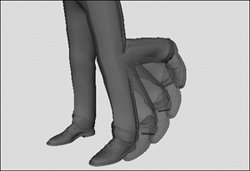Chapter 11. Parenting and Binding to a Skeleton
| Once you've created a skeleton, you need to either parent or bind your surfaces to the joints in order for them to move with the skeleton. Anything that doesn't need to bend, like a hat or glasses, can be parented to the joints. Anything that does need to bend, like an arm, leg, or torso, must be bound to the skeleton ( Figure 11.1). Surfaces that are bound are referred to as skins. Figure 11.1. For the leg to bend at the knee, it needs to be bound to a skeleton. Parenting to joints works the same way as parenting to anything else: When you move or rotate the joint, its child object(s) move or rotate as well. Binding, however, is a bit different. When a surface is bound to a skeleton, you can determine which portion of that surface moves with which joint. For example, in an arm, only the forearm should move when the elbow joint is rotated; the shoulder and biceps should remain in place (Figure 11.2). Figure 11.2. When the elbow joint is rotated, only the forearm rotates with it. There are two kinds of binding: rigid bind and smooth bind. Rigid bind assigns each of the object's points to one joint, although you can use flexors to create smooth deformations. Smooth bind allows each point to be influenced by any number of joints. A rigid bind can be easier to set up, but a smooth bind works better for areas that are affected by more than two joints, like a spine or a tail. |
EAN: 2147483647
Pages: 185

